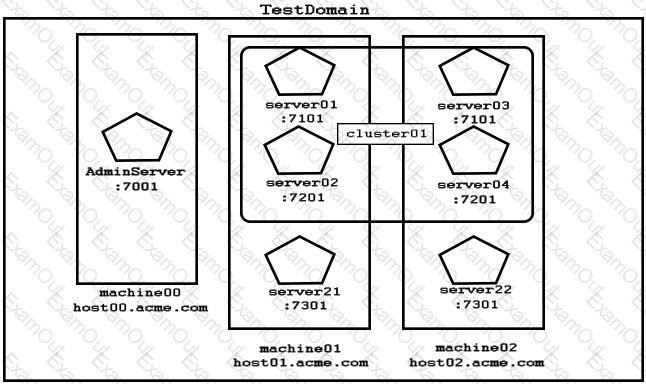Examine the domain diagram:

What is the correct path within the configuration hierarchy to the MBean that contains the log rotation parameters for server04? (Choose the best answer.)
You successfully configured a new dynamic cluster but haven’t launched any of the dynamic servers. You want to change the configuration for one specific server.
Which parameter can you modify for that server before starting up the dynamic clustered servers for the first time?
You have been tasked with deploying and targeting a new application to every server in a WebLogic cluster.
Some servers are running on machines that have access to a common shared file system, while other servers do not have that same access.
Currently, the default deployment staging mode for all servers in the cluster is set to STAGE – however, you wish to avoid having the AdminServer automatically copy the application to the servers (in that cluster) with shared file system access.
Which two approaches would satisfy the above requirement? (Choose two.)
My domain consists of an administration server and two managed servers. During runtime, my administration server has crashed and I wish to start the managed servers in MSI mode.
Which two files need to be copied from the admin server to the managed servers when starting them in this mode? (Choose two.)
You have a multithreaded application that looks up the WebLogic JMS ConnectionFactory object from the JNDI tree.
Which statement is correct in this scenario? (Choose the best answer.)
Which three WebLogic Server entities can be set up for service level migration? (Choose three.)
You are reviewing the scheduled maintenance of your domain after adding a new cluster.
Which statement is true when configuring a migratable target within a WebLogic Server cluster? (Choose the best answer.)
Your application has an auditing requirement that says that all audit events that have a severity of FAILURE must be logged and a notification must be sent to the application’s monitoring tier. The monitoring tier is implemented as a stateless session bean that provides an entry point called auditlog. The development team has provided you with the code that calls the monitoring tier.
How can you meet this requirement using WebLogic Server auditing? (Choose the best answer.)
Your domain is experiencing some intermittent problems that you are not able to figure out on your own. You have opened a case with Oracle Support to help you figure out the problem. The support engineer would like to use the WebLogic Diagnostic Framework (WLDF) to obtain an overall view of your WebLogic Server environment to try to narrow the problem to a particular subsystem.
What WLDF data does the support engineer request from you? (Choose the best answer.)
You are creating and configuring a production WebLogic Server (WLS) domain that is highly available. Which three WebLogic Server features allow you to best accomplish this requirement? (Choose three.)

